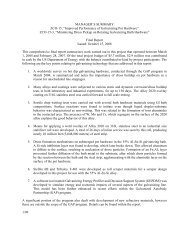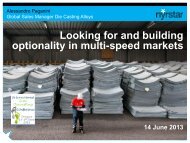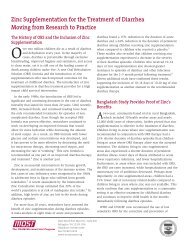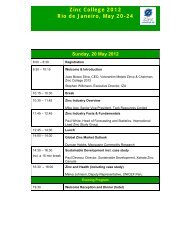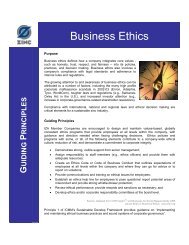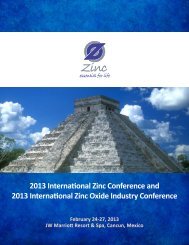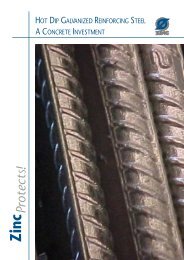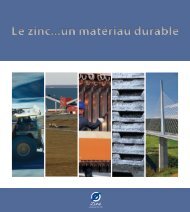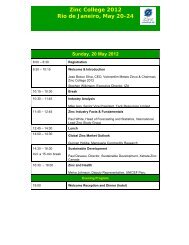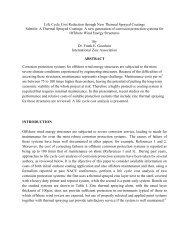Ultra Thin Zinc Die Casting Alloys - International Zinc Association
Ultra Thin Zinc Die Casting Alloys - International Zinc Association
Ultra Thin Zinc Die Casting Alloys - International Zinc Association
- No tags were found...
You also want an ePaper? Increase the reach of your titles
YUMPU automatically turns print PDFs into web optimized ePapers that Google loves.
2THE NEW GENERATIONOF ULTRA THINZINC DIE CASTING ALLOYSIntroductionA new generation of ultra thin zinc die casting alloys has beendeveloped that provides significant performance improvementscompared to conventional zinc die casting alloys. Featuring abetter fluidity, excellent surface quality, optimized mechanicalproperties and the ability to maintain close tolerances these alloyshave the potential of saving material, energy and costs andcreating new, innovative market opportunities.Initial efforts of improving zinc casting alloy fluidity date backto the 1990s when Union Minière, now Nyrstar, introduced its“Superloy”. Until then Alloy 7 was the zinc die casting alloy withthe highest fluidity. Because of its higher aluminum and coppercomposition Superloy has an excellent fluidity allowing for thinnercasting sections and lighter weight castings to be produced.Later, Grillo-Werke marketed this composition under the acronymof “GDSL” . 1More recently, with the objective of minimizing the time andexcess metal needed for alloy changeover, a new ultra thin zincdie casting alloy has been developed using a composition closerto the conventional ZAMAK alloys. This new alloy, designatedHF (High Fluidity) alloy has the same excellent castability ofSuperloy and GDSL and was developed by the <strong>International</strong> <strong>Zinc</strong><strong>Association</strong> (IZA) in cooperation with the North American <strong>Die</strong><strong>Casting</strong> <strong>Association</strong> (NADCA) and support from the US Departmentof Energy.With their superior fluidity the Superloy, GDSL and the HF Alloyare best suited for casting parts with a section thickness of lessthan 0.45 mm. They can also be used for casting parts that aredifficult to fill or have high surface finish requirements.1. GDSL: Guss-Druck-Sonderlegierung
3A Solid Foundation<strong>Zinc</strong> alloys have many unique benefits for the die casting process; they are strong, durable and costeffective. Their mechanical properties compare favorably with cast aluminum, magnesium, bronze,plastics and cast irons. These characteristics, together with their superior finishing capabilities andchoice of casting processes make zinc alloys a highly attractive option for modern die casting.<strong>Zinc</strong> is also considered the most energy efficient of the engineering alloys by virtue of its low meltingpoint and superior net-shape casting capability (which allows for reduced machining operations). <strong>Zinc</strong>alloys also offer the fastest production rates and longest tool life.1Assembly operations are reduced.Entire assemblies can be cast as a single unit, eliminating the need for expensivemanual assembly operations.234Less material is required.<strong>Zinc</strong>’s superior casting fluidity, strength and stiffness permits the design of thin wallsections for reduced weight and material cost savings.Machining operations are reduced.Due to the superior net-shape casting capability of zinc alloys, machining can beeliminated or drastically reduced.Choice of low, medium and high production.A variety of casting processes are available to economically manufacture any size andquantity required.56Eliminate bearings and bushings.<strong>Zinc</strong>’s excellent bearing and wear properties allow greater design flexibility and reducesecondary fabrication costs by eliminating small bushings and wear inserts.Faster production and extended tool life.<strong>Die</strong> casting production rates for zinc are much faster than for aluminum, or magnesium.Coupled with a tool life often exceeding 1 million parts, tooling and machineusage charges are dramatically reduced.
The <strong>Ultra</strong> <strong>Thin</strong> <strong>Zinc</strong> <strong>Die</strong> <strong>Casting</strong> <strong>Alloys</strong>5The development of the ultra thin zinc die casting alloys is based on two different approaches:The Superloy/GDSL Alloy identified a composition with higher aluminum and copper levelswhereas the recently developed HF Alloy is based on the commonly used ZAMAK alloys butpossesses the excellent castability of the Superloy/GDSL (Table 1). A laboratory fluidity testcomparing the Superloy/GDSL and HF Alloy to Alloy 7, which is the most fluid of the conventionalzinc die casting alloys, showed respectively a 42% and 40% greater fluidity of the ultra thin zinc diecasting alloys. The experimental results from the fluidity testing are reported in Figure 1.Table 1:Composition Ranges (wt%) of the New <strong>Ultra</strong> <strong>Thin</strong> <strong>Zinc</strong> <strong>Die</strong><strong>Casting</strong> <strong>Alloys</strong>Superloy/GDSLHF AlloyAluminum 6.4 - 6.8 4.3 - 4.7Magnesium 0.02 max 0.005 - 0.012Copper 3.3 - 3.6 0.035 maxIron 0.05 max 0.03 maxLead 0.005 max 0.003 maxCadmium 0.005 max 0.002 maxTin 0.002 max 0.001 max<strong>Zinc</strong> remainder remainder500 400 300 200 100 0 Alloy 7 HF Superloy/GDSL Figure 1:Ragone fluidity distances of Alloy 7, the new HF Alloy and Superloy/GDSL, castat 435°C (815F)
6Tests with the new HF Alloy have demonstrated that the alloy has comparable physical, mechanical andcorrosion properties to <strong>Alloys</strong> 3 and 7 and exceeds minimum thickness targets allowing for casting partswith a wall thickness as thin as 0.25mm.Several industrial trials and evaluations have been carried out confirming the easy use and integration of theHF Alloy in existing die casting operations minimizing changeover time and increasing productivity.The Superloy/GDSL Alloy provides similar manufacturing advantages to the die caster.<strong>Thin</strong> Section Filling AbilitySuperloy/GDSL’s ability to make ultra-thin (0.3mm) castings in 1, 2 and 3 dimensions is shown in the photosbelow.1D 0.3mm 2D 0.3mm 3D 0.3mmFigure 2:The tensile bar castingshows the abilityof completely filling a175mm long cavity.Figure 3:Extended to 2 dimensions for theflat plate.Figure 4:Extended to a 3-dimensionalcover casting with dimensions80x80x20mm.
7The filling behavior of the HF Alloy compared to the most widely used conventional Alloy 3 with 25ms filltime is shown below in Figure 5 and Table 2.Alloy 3HF AlloyFigure 5: The more complete filling with the HF Alloy, even though a lower die temperatureof 200°C (392°F) was used, in comparison with the 225°C (437°F) die temperatureused for Alloy 3.Table 2:Filling Results of Superloy/GDSL and the HF Alloy1-D specimen thickness 0.5mm 0.4mm 0.3mm 0.3mm150°C200°C220°C260°CCavity temperature(302°F)(392°F)(428°F)(500°F)Filling ResultsSuperloy/GDSL Alloy yes yes yes yesHF Alloy yes yes yes yesZL0400 yes yes no yesZL0410 yes yes no yesZL0430 yes yes no noZL0810 yes no no no
12Draft BehaviorDraft, or taper, is created on die casting surfaces perpendicular to the parting line for proper ejectionfrom the die. Recommended draft is a function of depth or length of the feature from the partingline. In many cases the ultra thin zinc die casting alloys, as with other zinc die casting alloys, canbe cast with zero draft if die temperature is carefully controlled to prevent die soldering.Process StabilityComparisons were made of 30 samples ofdoor lock parts cast in both Alloy 5 andthe HF Alloy. Results showed that the HFcastings weighed less on average due totheir slightly higher aluminum (Al) contentwhile also showing greater consistencydue to their more uniform die fillingbehavior (Fig. 9). A similar stability wasseen in earlier tests carried out with theSuperloy/GDSL Alloy.Figure 9: This automobile door lock is difficult to consistently fill with conventional Alloy 5. The HFalloy provided consistent casting weights, allowing for zero-draft precision casting.Alloy 5HF AlloyPart No. 1 2 1 2Average Weight (g) 19.9796 54.2745 19.6982 53.6358Std. Dev. 0.076 0.046 0.034 0.036Figure 10: <strong>Casting</strong> appearance after blister testing, 310°C, 90 minutes
Surface Finishes13The ultra thin zinc die casting alloys, like all zinc die castings, accept a wide assortment of surface finishes,including traditional solvent-based painting, electroplating and hexavalent chromium conversion coatingswhich have been providing reliable performance for decades as well as new electrophoretic surface finishesusing best practice green technology. These new green finishes are free of cadmium or lead and dowithout chromium plating topcoats while providing high corrosion protection and appealing aesthetics.Almost any desired aesthetic characteristic can be achieved making the ultra thin zinc die casting alloyslook like solid gold, weathered brass, stainless steel and even leather. The majority of zinc die cast applicationsare not exposed to corrosive environments and it is appearance requirements that define whichfinish, if any will be used. The new green finishes offer an environmentally friendly alternative to the enduserand parts manufacturer.The charts below show the relative performance for the various types of traditional and green finishesin terms of corrosion protection and retention of aesthetics (Figs. 11 and 12). The finishes with the bestoverall performances are in the upper-right portion of the chart.Figure 11. Green Finishes1. Tin-nickel alloy plating2. Electroless nickel plating3. Black nickel plating4. Black electrophoretic coating (sample A)5. Black electrophoretic coating (sample B)6. Clear electrophoretic coating, stainless steel effect post dye7. Clear electrophoretic coating with gold post day8. Clear electrophoretic coating with brass effect post dye9. Clear electrophoretic coating with bronze effect post dye10. Antique bronze electrophoretic coating11. Oil-rubbed bronze eletrophoretic coating12. Oil-rubbed bronze electrophoretic, polyurethane topcoating13. White electrophoretic coating14. Blue electrophoretic coating15. Blue electrophoretic coating plus polyurethane top-coatingFigure 12. Traditional FinishesA. <strong>Zinc</strong> BlackB. Cu-Sn-Zn ElectroplateC. Clear Chromate and Trivalent ChromiumD. Sprayed & Baked Liquid CoatingsE. Hexavalent Chromium ConversionF. Mechanical PlatingG. Cu-Ni-Cr ElectroplatingH. Epoxy & Polyester Powder CoatingsI . Urethane Resin E-Coats
14Saving Weight, Costs, & ResourcesThe ultra thin zinc die casting alloys offer the potential of saving material, weight, time, energy and costsrelative to other engineering alloys. Their unique technical properties are being recognized by somedesigners and users and will impact the market.The GDSL alloy has demonstrated its exceptional castability in the manufacturing of a bevel gear usedin fully retractable arm awnings that provide shade to balconies and terraces (Fig. 13). This fine gear partresides in the awning’s case and serves to extend and retract the awning. Due to its mechanical propertiesthe copper-rich GDSL is ideal for the thin section filling of this complex-shaped bevel gear (Fig. 14).Figure 13: photo courtesy of Geiger/JenersFigure 14: photo courtesyof Geiger/JenersAnother example is a religious communion wafer dispenser originally designed in the Al A360 alloy. Therequirement for a high quality gold surface finish made the casting excessively expensive. <strong>Casting</strong> in thenew HF Alloy allowed for a decrease in section thickness from 2.54 to 1.27 and significant reduced thecost. The resulting zinc casting had nearly the same weight as its aluminum predecessor and, as shown inFigure 15, improved cast-in interior features. It also met a key requirement, which was to survive withoutdamage a drop of 1 meter (3.2 ft) onto a stone floor.Figure 15
15<strong>Ultra</strong> thin alloys also show promise in the design of more effective heat sinks. The performance of heat sinksdepends more on the available fin area for convective heat transfer than the fin thickness conducting the heat.The HF Alloy allows for producing 0.25mm thick fins making possible high performance, low cost heat sinks incustom shapes. Cost savings of 75% compared to heat sinks made of machined aluminum have been realized.The ultra thin alloys also share zinc’s capabilities of providing electromagnetic shielding in connectors andhousings. Even in 10GB Ethernet connectors, a 0.2mm zinc section thickness provides complete shielding avoidingsignal coupling and crosstalk. Another advantage is the production of a near-net shape part.A case study comparing the HF Alloy (Fig. 16) to aluminum in the production of a cell phone case showedenormous savings when using the HF Alloy. It takes 20 minutes to machine the aluminum forged blanks versus2 minutes to machine the zinc die castings. Based on a production level of 1 million cell phones per month thecost saving for machining alone is USD 60,000 per month, or US$ 720,000 per year. The energy savings for machining,coupled with the difference in melting aluminum for forging stock versus melting zinc for die casting isestimated to 1,113MWh (3.8 billion BTU) per month or 13,364MWh (45.6 billion BTU) per year.Other advantages over aluminum are zinc’s higher yield strength and ultimate strength compared to the aluminumalloy. The HF Alloy also allowed for casting to the desired 0.4mm wall thickness. Production was done ona four-slide zinc die casting machine accommodating undercuts and other details not achievable with currentaluminum or magnesium die casting alloys.Figure 16
16Environmental SustainabilityHumans need zinc for a multitude of critical functions. It positively affects the immune system, growth anddevelopment, fertility, eyesight, learning and wound healing. In some areas of the world zinc deficiency is amajor health problem.Pollution and greenhouse gases are minimized with zinc die casting:> Negligible emissions to air, land and water.> Much smaller energy consumption than comparable alternative mass manufacturing processes.> No environmentally harmful blanket gases required in processing.> Any ‘scrap’ product from processing can be recycled.<strong>Zinc</strong> alloys, as defined by international chemical composition standards, easily conform to the requirementsof the End of Life Vehicle (ELV), Restriction of Hazardous Substances (RoHS) and Waste Electricaland Electronic Equipment (WEEE) legislation.<strong>Zinc</strong> die castings are premium quality low cost products that are highly resilient to many hostile conditions.They display considerable corrosion and wear resistance resulting in very long and reliable service,frequently measured in decades, and saving resources by not needing to be frequently replaced.• A recycling infrastructure is actively in place to treat today’s zinc processing scraps and tomorrow’send of life cast zinc alloy products. <strong>Zinc</strong> castings can be marked with the <strong>Zinc</strong> Logo and the ISO recyclingmark as featured in EN 12844 for easy alloy recognition and future recycling.• <strong>Zinc</strong> is an inherent part of the Earth’s crust and one of nature’s most abundant elements. Over 13million tons of zinc are produced annually. <strong>Zinc</strong> has a broad range of applications, including galvanizing,brass, chemicals and diecasting. Approximately 15% of zinc metal goes into the production of zincalloys for die casting. <strong>Zinc</strong> die casting has a long tradition dating back to the development of Zn-Alcasting alloys in the 1930’s.References1. The New High Fluidity <strong>Zinc</strong> Alloy, <strong>International</strong> <strong>Zinc</strong> <strong>Association</strong>; North American <strong>Die</strong> <strong>Casting</strong> <strong>Association</strong>;US Department of Energy, 20132. A Performance Evaluation of Traditional and Green Surface Finishes for <strong>Zinc</strong> <strong>Die</strong> <strong>Casting</strong>s, <strong>International</strong> <strong>Zinc</strong><strong>Association</strong>, 20133. <strong>Zinc</strong> … A Sustainable Material, <strong>International</strong> <strong>Zinc</strong> <strong>Association</strong>, 2010© <strong>International</strong> <strong>Zinc</strong> <strong>Association</strong>, 2013 - www.zinc.org



